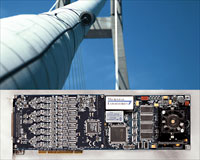
Data Acquisition: A Useful Resource
Case Studies in Applied Ingenuity
NEWS FOR IMMEDIATE RELEASE |
|---|
|
For more information, contact |
Bellevue, WA, April 24, 2007 -- If you want to see how other engineers have designed data acquisition systems that may closely model one you have in mind, take a look at www.mstarlabs.com. Microstar Laboratories, maker of Data Acquisition Processor (DAP) boards and software, has published on the Web several application write-ups that look at a wide range of situations where an engineer has answered the question, "How can a Data Acquisition Processor board help me do what I need to do?"
The applications described include one that performs in-place diagnosis of control valves for the process industry and another that analyzes broadband sonar to detect fish size and species in real time. There seems to be no one 'typical' industry or application for DAP boards and software. One unusual application now installed all over the world was developed by a company from Calgary, Alberta.
Pure Technologies, Ltd., based in Calgary, has created a patented infrastructure monitoring system that uses acoustical techniques to detect potential failures in buildings, parking structures, bridges, prestressed concrete pipelines, arenas, and containment vessels. Called SoundPrint®, the system uses an array of sensors to measure the energy released when tensioned steel wires fail. Recent contracts include the Chesapeake Bay Suspension Bridge in Maryland and the Forth Road Bridge in Scotland. With the completion of these projects the system will be installed on nine major cable-supported bridges around the world.
“Microstar understands how people write software, and tailored their API so it really makes sense.”
Monroe Thomas, Vice President, Pure Technologies Ltd
Customers like Pure Technologies can take advantage of the hardware and software engineering that Microstar Laboratories has built in to all DAP products to allow their use in Windows applications with timing-sensitive components. Unless these Windows applications use independent real-time processing as implemented in DAP products, they could be adversely impacted at runtime by system or network delays.
Control Technology
The same section of the Microstar Laboratories Web site includes a number of items on control technology. Every DAP board includes an onboard processor with a real-time operating system that Windows applications can control. This extra resource frees the time-critical parts of your application from system delays and lets you implement control systems that otherwise would be difficult or even impossible to implement under Windows. To get an idea of how a DAP board can help you do what you need to do in your control application, check out these items on the Web site:
- Performance that optimizes itself
- Configuring high-performance PID
- Rough data, smooth signals
- Self-testing control loops
and much more ...when you go to https://www.mstarlabs.com/control.html.
Conclusion
Microstar Laboratories has made available a useful resource. It makes sense to use it. Visit www.mstarlabs.com and click on Applications.
# # #
Editorial Overview:
You know the feeling. You want to build your application to run under Windows, but you wonder about system and network delays and their potential impact in the field on timing-sensitive components of your project. Maybe the time has come to take a look at some answers to the question, "How can a Data Acquisition Processor (DAP) board help me do what I need to do?" Microstar Laboratories, maker of DAP boards and software, has published on the Web several application write-ups that look at a wide range of cases where an engineer has answered that question. One of those answers could work for you. Every DAP board includes an onboard processor with a real-time operating system that Windows applications can control. This protects your implementation from system delays and lets you develop applications that otherwise would be difficult or even impossible to run reliably under Windows. It makes sense. Check it out.
Note to the Editor:
Microstar Laboratories suggests this text as a caption for the available image:
The SoundPrint® system uses arrays of sensors connected to DAP boards to measure the energy released when tensioned steel wires fail. Pure Technologies now has installed the system on nine major cable-supported bridges around the world, including the Chesapeake Bay Suspension Bridge in Maryland, the Forth Road Bridge in Scotland, and the Quincy Bayview Bridge in Illinois, shown here.
Microstar Laboratories, Inc. claims Microstar Laboratories, Data Acquisition Processor, and DAP as trademarks. Microsoft has registered Windows as a trademark. Pure Technologies Ltd. has registered SoundPrint as a trademark. Other organizations may claim – or may have registered – as trademarks any trade names, logos, and service marks that appear in this document but not in the list above.
Microstar Laboratories makes it a practice to use an appropriate symbol at the first occurrence of a trademark or registered trademark name in a document, or to include trademark statements like this with the document.
